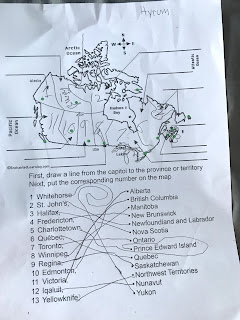MAXWELL MCKAY age 14yr 4 months Grade 8.
MATH (side note- Maxwell is WAY above this level. I had to find worksheets that Hyrum and Daniel were doing and print them for Maxwell to do. But it was a good review. Somewhere along the way, Maxwell took an accelerated leap in math.)
Squares & Square Roots- Demonstrate and understand perfect squares & square roots.
Approximating Square Roots- Apoximate √ of non-perfect squares. (Whole numbers)
Percents- Show an understanding of percents. (0%-100% and greater than 100%)
Rate & Ratio- Demonstrate an understanding of ratio and rate. AND
Proportional Reasoning- Solve problems involving rates, ratios & proportion reasoning.
× ÷ Fractions- Multiply and divide positive fractions & mixed numbers. AND
× ÷ Integers- Multiply and divide integers.
Graphing Equations- Graph and analyze two-variable linear relations.
(function tables & line graphs) AND
(function tables & line graphs) AND
Solving Equations- Model & solve linear equations of the form: (ax = b) (x/a = b)
(ax + b = c) (x/a + b = c) a(x + b) = c where a, b and c are integers.
(ax + b = c) (x/a + b = c) a(x + b) = c where a, b and c are integers.
Pythagorus Theorem- Develop and apply the Pythagorean theorem to solve problems.
Volume- Develop and apply formulas for volume of prisms & cylinders.
Evaluate Graphs- Critique ways data is presented. (Circle, line, bar, pictographs, etc.)
Probability- Solve problems involving the probability of independent events.
(Use experimental or theoretical probabilities to solve problems involving uncertainty)
(Use experimental or theoretical probabilities to solve problems involving uncertainty)
LANGUAGE ARTS
Reading
Read, listen to, view a variety of literature from different genres. (keep a list)
Hunger Games Trilogy
Gregor the Overlander Series
The Swiss Family Robinson
The Heroes of Olympus Series
Warriors Series
Saints Standard of Truth
The Lonesome Gods
Laddie a true blue Story
Little Britches Series
Beyonders Series
Summer of the Monkeys
White Fang
The Call of the WIld
Journey to the Center of the Earth
Little Women
and a whole bunch of Minecraft junk books not worth mentioning.
Also a bunch more, I can't keep up with everything he reads, honestly.
Use reference materials. (text, dictionary, thesaurus, writer's handbook)
Find answers to questions using a variety of resources. (Keep a research log/list)
Understand organizational patterns. (numbering, bullet points, table of contents, indices…)
Understand basic story elements. (plot, setting, character, theme, conflict, climax and resolution)
BrainPOP
Distinguish between fact & opinion.
BrainPOP
Express preference for a favorite book, movie, poem or website & tell why.
Recognize different points of view in writing. 1st (“I”), 2nd (you) & 3rd person (he, she, they)
BrainPOP
Understand exaggeration, dialogue, suspense, foreshadowing, flashback & figurative language.
BrainPOP
Writing
Use graphic organizers such as mind mapping, labeling, outlines to apply new info. to prior knowledge.
Use a notebook for notetaking: combining, extending, representing & summarizing ideas.
Write from different points of view. (1st, 2nd & 3rd person) keep samples for portfolio.
So in this writing assignment he writes in first person how HE makes coconut pudding and references to 2nd person, saying that YOU should do the same. Does that count?
And for 3rd person, there's tons of examples in this post.
Compare & contrast a movie to a book.
Choose 2 pieces of personal writing to edit & share. (Showcase the entire writing process)
Demonstrate presentation skills (eye contact, use of posters, voice level, etc.)
He gave a talk in church....does that count?
Demonstrate word processing & editing skills.
I'll send you (John) something he typed up without any help.
Attend to conventions: spelling, capitalization, grammar and punctuation.
By the way, this is just one page of MANY grammar pages that he's worked on. Fix It! Grammar is very good.
Paraphrase main ideas from a source. Rework. Write in own words. Cite references.
use a consistent and approved format to give credit for quoted ideas and information.
Understand font choices (size, color) and the influence on the writing.
He reads everything in the Dyslexia font, which he chooses. He chose this after playing with font size and colour on his kindle a TON!
SOCIAL STUDIES
From Isolation to Adaptation: Japan
Origins of a Western Worldview: Renaissance Europe
BrainPOP
Worldviews in Conflict: The Spanish and the Aztecs
BrainPOP
Mapping Skills-look on my blog for memorization of countries and landmarks etc.
Current Events-look on my blog, I know I have lots of photos
SCIENCE
Mix & Flow of Matter
BrainPOP
Cells & Systems
BrainPOP
Light & Optical Systems
BrainPOP
Mechanical Systems
BrainPOP
Freshwater & Saltwater Systems
BrainPOP































































